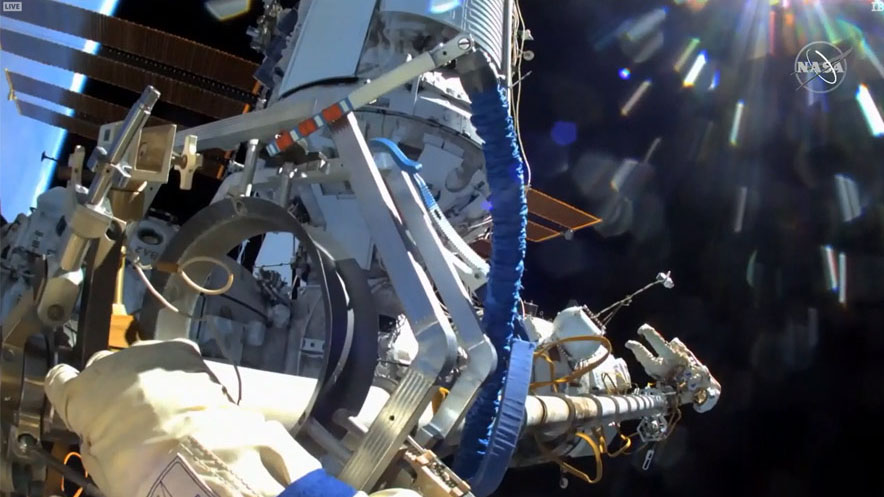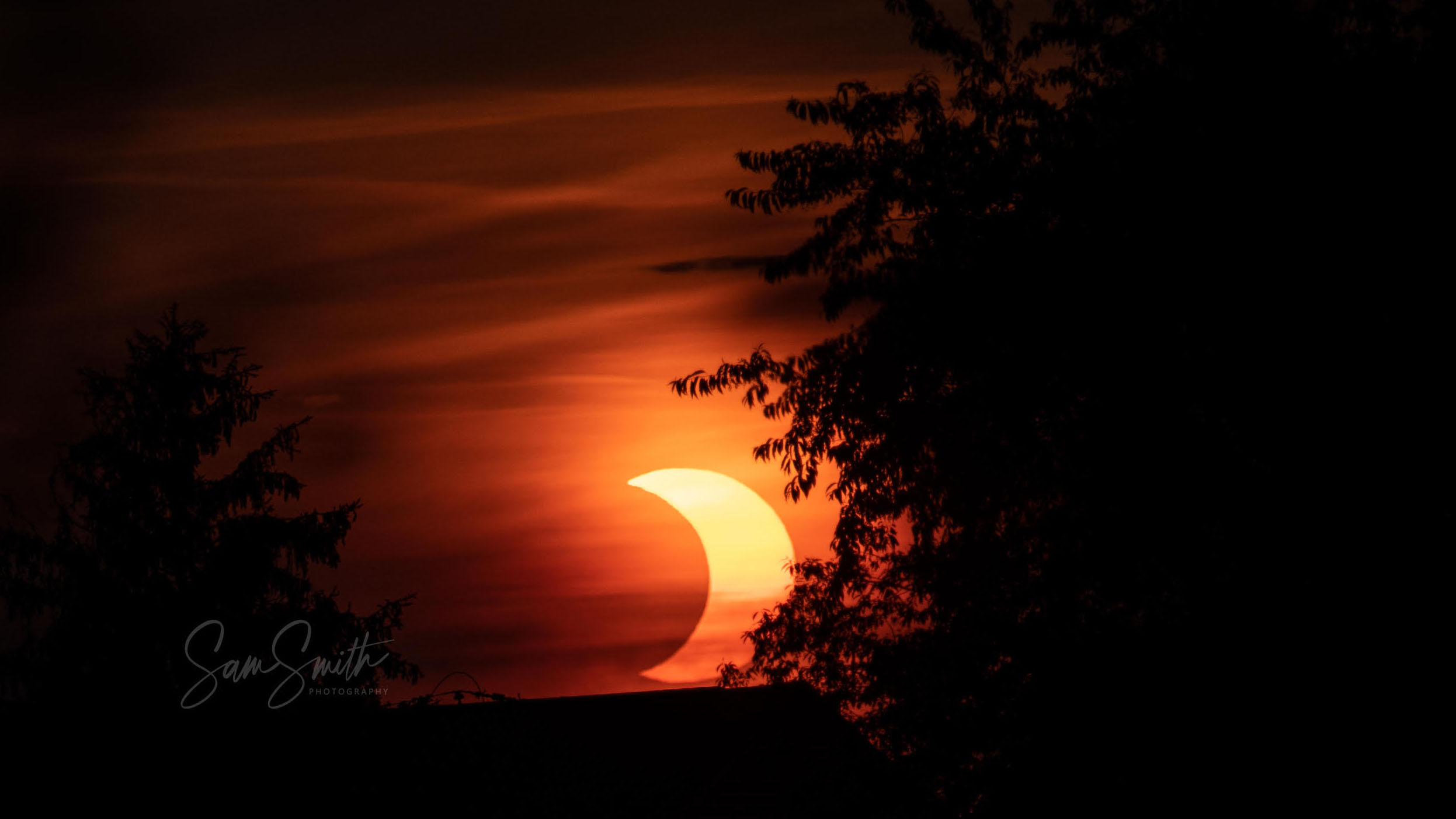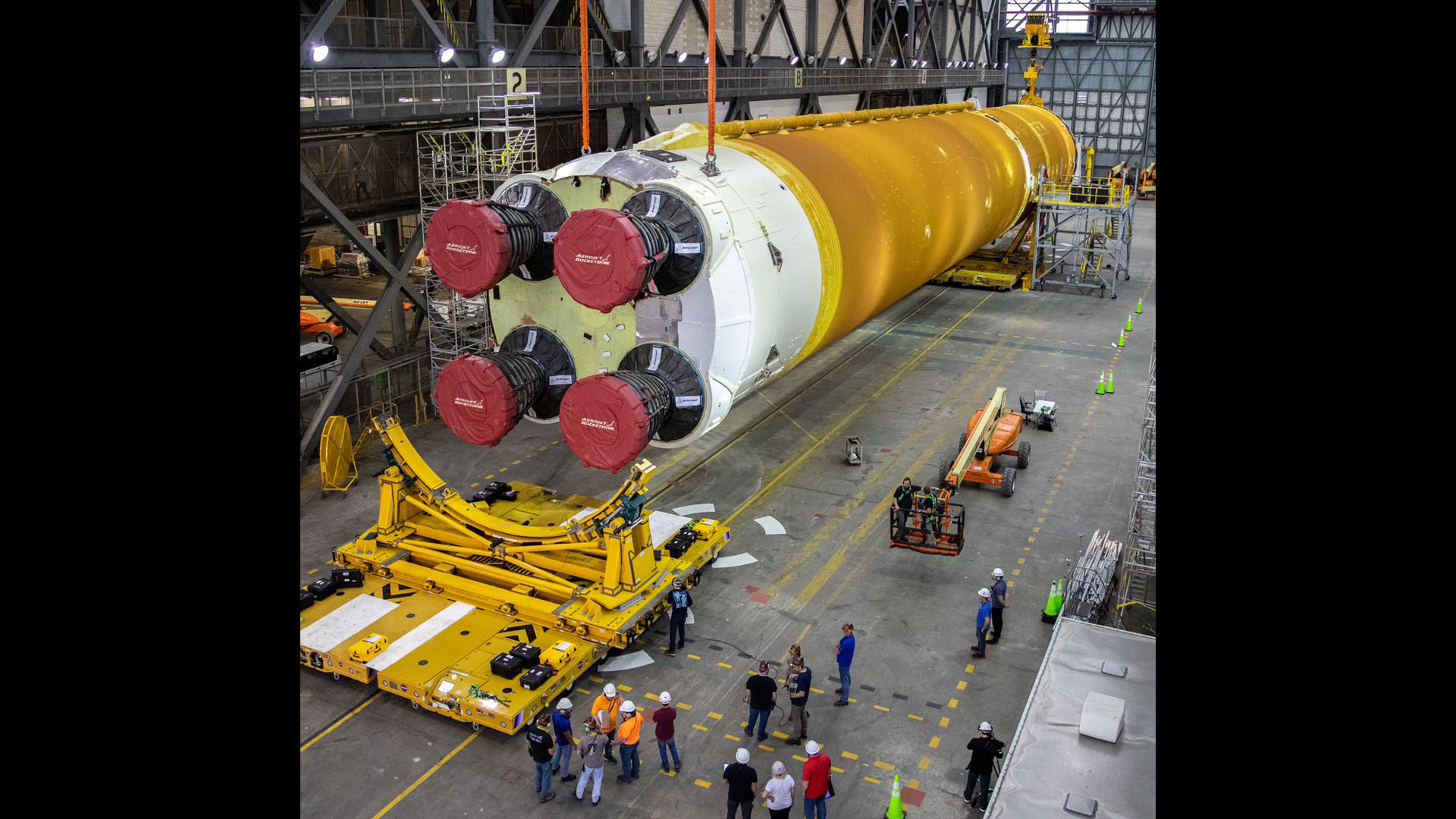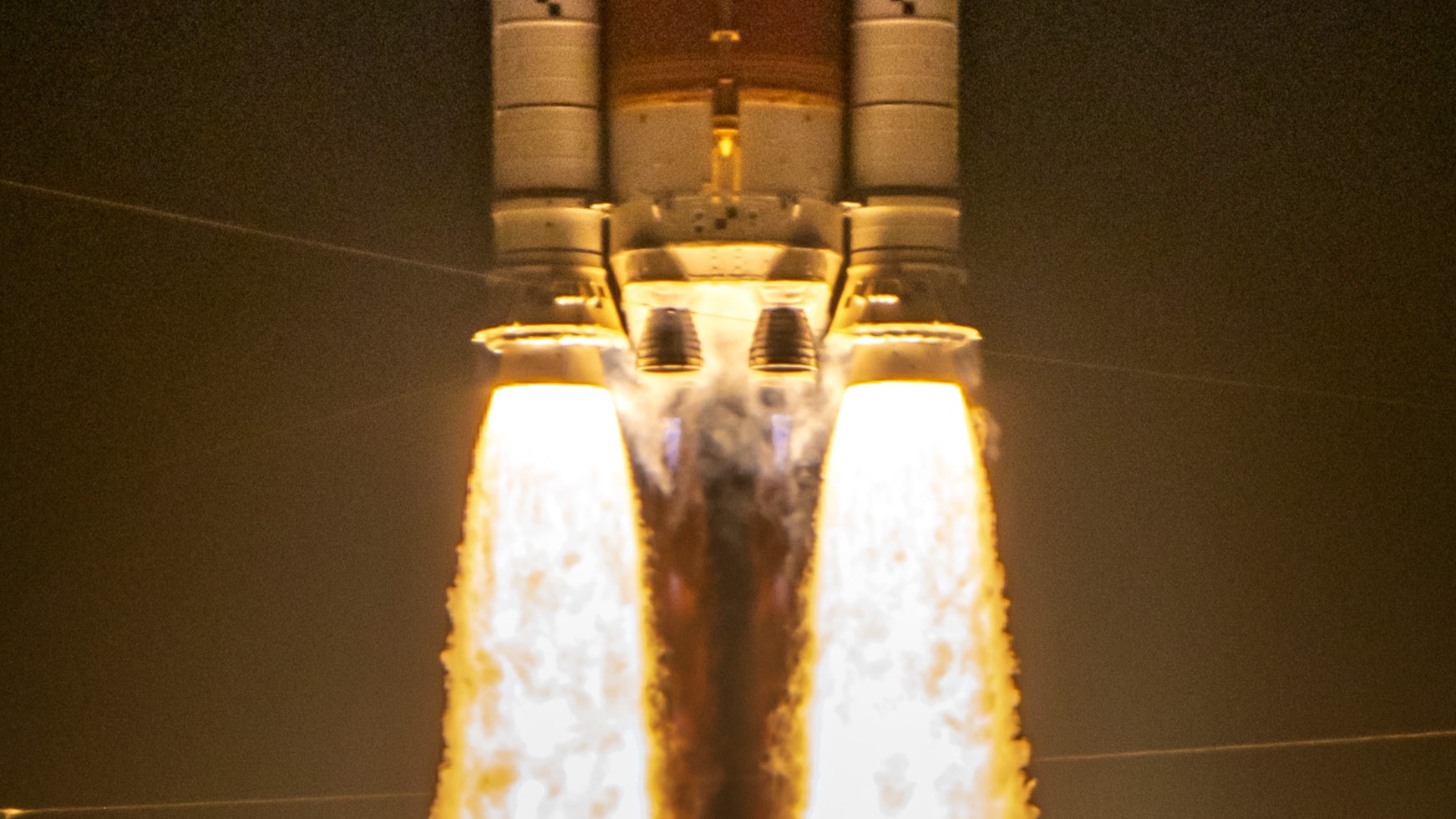June 2021
Rare snowfall in driest place on Earth captured by satellites

Tuesday, June 1, 2021: Heavy snowfall covered the Atacama Desert in Chile with up to 6 inches (15 centimeters) of snow last week as captured in this image taken by the European Sentinel-2 satellite. The Atacama Desert, which spreads along the Pacific coast of South America from central Chile up to southern Peru, receives on average less than 0.6 inches (1.5 centimeters) of rainfall per year, and is generally considered one of the driest places on Earth.
In this image, the Los Flamencos National Reserve near Chile's borders with Argentina and Bolivia, is blanketed with snow under the rain-bearing clouds. Located in the foothills of the Andes, the reserve usually receives about 0.12 inches (3 millimeters) of rainfall a year. Chile’s meteorological agency said the unusual snowy weather will not continue in the upcoming weeks and the region will return to its usual dry and sunny climate. -- Tereza Pultarova
Spacewalkers prepare old module for disposal

Wednesday, June 2, 2021: Russian cosmonaut Oleg Novitsky can be seen at the end of the 46-foot-long (14 meters) Strela crane during a seven-hour spacewalk conducted on Wednesday, June 2, at the International Space Station. The image was captured by the helmet camera worn by Novitsky's colleague Pyotr Dubrov. During the spacewalk, the two cosmonauts disconnected cables between the 20-year-old Pirs docking module and the Zvezda service module and relocated the Strela crane, which was originally attached to Pirs. The work was part of preparations for the disposal of Pirs later this year and the installation of the replacement Multi-purpose Laboratory Module Nauka, which will arrive at the space station in July.
During the spacewalk, the cosmonauts also replaced the fluid flow regulator panel attached to the Zarya module. They then jettisoned the old panel by pushing it away from the space station in the direction of Earth. NASA said the panel will burn in the atmosphere. -- Tereza Pultarova
Rocket that will return humans to the moon being assembled by NASA

Thursday, June 3, 2021: Engineers at NASA’s Michoud Assembly Facility in New Orleans have integrated first elements of the Space Launch System (SLS) rocket, which will propel humankind's return to the moon in 2023. Last week, engineers at Michoud stacked the rocket's forward skirt with the liquid oxygen tank and the intertank flight hardware, which houses avionics, the flight computer and electronic systems of the rocket stage.
The 66 foot (20 meters) tall upper part of the stage is just a fraction of the entire core stage, which will be 212 foot (65 meters) tall when fully assembled.
The joining of these three structures together is the first major assembly of core stage hardware for the Artemis II mission, which will be the second flight of the SLS rocket. SLS will be put to the test for the first time later this year as part of the uncrewed Artemis I mission that will fly around the moon and return back to Earth. -- Tereza Pultarova
Get the Space.com Newsletter
Breaking space news, the latest updates on rocket launches, skywatching events and more!
ExoMars rover Earth twin starts Mars-yard training

Friday, June 4, 2021: The Ground Test Model of the European Exomars Rosalind Franklin rover has completed its first drive in a Mars yard, which simulates not only the type of surface the rover will encounter on the red planet but also the reduced gravity.
The Ground Test Model is an exact replica of the rover that will be sent to Mars in September next year (if all goes according to plan) and will help engineers to finetune various aspects of the rover’s operations ahead of the landing on the red planet in 2023.
Last month, the replica was moved from the facilities of the integrator Thales Alenia Space in Turin, Italy, to the neighbouring Rover Operations Control Center Mars Terrain Simulator. In the image, the model can be seen suspended on cables attached to a mobile crane. The support system absorbs two thirds of the rover’s weight of 640 lbs. (290 kilograms) to make it move as lightly as it would on Mars. The rover operators will use the replica to practice moving across different types of Martian surface but also to test the 6.5-foot-long (2 meters) drill, which will (hopefully) help the real Rosalind Franklin find traces of life under the Martian surface. -- Tereza Pultarova
Dragon cargo ship arriving at space station

Monday, June 7, 2021: European astronaut Thomas Pesquet took a picture of the approaching Dragon Cargo capsule shortly before its docking at the International Space Station (ISS) on Saturday 5 June. Pesquet, who arrived at the orbital outpost in April as part of Crew-2 on board of SpaceX's Crew Dragon capsule Endeavour has posted the image on Instagram, commenting that the cargo ship disrupted the crew's usual Saturday cleaning routine as astronauts had to focus on unpacking the freshly delivered supplies. Pesquet added that technology has advanced since his previous stay at the orbital outpost in 2016 as back then the SpaceX Cargo Dragon vehicle had to be attached to the station with a robotic arm instead of doing it autonomously.-- Tereza Pultarova
Juno’s first close-ups of Jupiter’s moon Ganymede

Wednesday, June 9, 2021: Jupiter’s moon Ganymede, the largest moon in the solar system, can be seen in one of the first close-up images captured by the Juno space probe during its closest flyby at the moon to date. Surface features including craters and terrain discolorations along tectonic faults can be seen in the images captured on Monday, June 7, by Juno’s JunoCam camera. During the flyby, Juno was about 645 miles (1,038 kilometers) from Ganymede’s surface, the closest any spacecraft has been since the Galileo mission in the early 2000s.
NASA released this preliminary image taken through JunoCam’s green filter on Tuesday, June 8, one day after the closest approach. Juno scientists will now process the images, stitching together the three images taken separately through the camera’s green, read and blue filters. -- Tereza Pultarova
Sunrise adds more magic to solar eclipse

Thursday, June 10, 2021: The giant crescent of the sun rising during the partial solar eclipse today, June 10, photographed by Samuel Smith from Middletown, Delaware, the U.S.. Observers on the U.S. West Coast couldn’t see the full annular eclipse, a type of eclipse that occurs when the moon is too far away from Earth and doesn’t cover the solar disk completely, leaving a “ring of fire” around as it passes in front of the sun.
Still, the combination of the partial eclipse and the sunrise (the eclipse peaked at about 6:14 AM Eastern Day Time) provided spectacular opportunities for skilled photographers. In some places, however, cloudy weather complicated or even ruined the event. -- Tereza Pultarova
SLS core stage lifted ahead of booster integration

Friday, June 11, 2021: The core stage of NASA's Space Launch System (SLS) rocket, which will pave the way for humankind's return to the moon, has been lifted out of its stand ahead of integration with solid rocket boosters.
The 212-foot (65 m) tall stage arrived at Kennedy Space Centre in late April this year after a series of tests at Stennis Space Centre. Engineers will now integrate the core stage with the mobile launcher platform and the twin solid rocket boosters. Together, the stack will provide more than 8.8 million lbs of thrust to launch the unmanned Artemis I mission to the moon in November this year, testing the Orion space capsule ahead of future missions with astronauts.-- Tereza Pultarova
First look at SLS rocket in launch configuration

Monday, June 14, 2021: Engineers at NASA's Kennedy Space Centre in Florida assembled three main elements of the Space Launch System (SLS) rocket into their launch configuration for the first time. The rocket, capable of generating more than 8.8 million lbs of thrust, will power the Artemis I mission, which will launch later this year and test an uncrewed Orion module in a flight to the moon and back prior to the first lunar mission with astronauts in 2023
On Friday, the teams working at the iconic Vehicle Assembly Building, lowered the 212-foot (65 m) tall core stage onto the mobile launcher platform between the two smaller solid rocket boosters, then secured the boosters to the core stage.
The 212-foot (65 m) tall stage arrived at Kennedy Space Centre in late April this year after a series of tests at Stennis Space Centre. -- Tereza Pultarova
Jupiter explorer JUICE ready for space simulation

Tuesday, June 15, 2021: The European Space Agency’s (ESA) future Jupiter exploring spacecraft JUICE, which will search for signs of life on the ice-covered moons in the Jovian system, is getting its first taste of a space-like environment in the Large Space Simulator at ESA’s facilities in the Netherlands. During a month-long test campaign, the spacecraft, built by European aerospace giant Airbus, will be subject to extreme temperature cycles, vacuum and radiation, similar to what it will experience on its journey to Jupiter.
Equipped with a suite of remote-sensing instruments, Juice will make detailed observations of Jupiter and its three large ocean-bearing moons – Ganymede, Callisto and Europa – searching for possible chemical signatures of life. --Tereza Pultarova
Starliner readied for July test flight

Wednesday, June 16, 2021: NASA and Boeing engineers are preparing the Starliner space capsule for its second uncrewed test flight to the International Space Station in late July. The teams at NASA's Kennedy Space Center in Florida started fuelling the capsule this week ahead of the its transfer to the Vertical Integration Facility at Space Launch Complex-41 on Cape Canaveral Space Force Station, where it will be mated with the United Launch Alliance Atlas V rocket.
Starliner's first test flight in December 2019 failed to reach the space station due to software errors and communication dropouts. A joint NASA-Boeing review team then recommended a set of improvements related to testing and simulations, operational processes, software requirements and the working of the crew module communication system. -- Tereza Pultarova
Astronaut Thomas Pesquet riding the robotic arm during spacewalk

Thursday, June 17, 2021: European Space Agency astronaut Thomas Pesquet attached to the tip of the robotic arm at the International Space Station during a spacewalk on Wednesday (June 16). During the 7 hour and 15 minute spacewalk, Pesquet and his colleague NASA astronaut Shane Kimbrough installed a new ISS Roll-Out Solar Array (iROSA) into its mounting bracket on the station’s backbone truss structure.
In this image, Pesquet can be seen waving into the camera after letting go of the rolled up 750 lbs (350 kg) iROSA solar array.
"It was both a magical experience and a real struggle," Pesquet tweeted after the spacewalk. "I'm not ready to forget this little trick at the end of the robotic arm while holding a piece of equipment that is 3 times my weight." He then complimented fellow crew member, NASA astronaut Megan McArthur, who controlled the robotic arm during the operation to her skills. "Fortunately, @Astro_Megan is a robotic arm driving trophy champion."
Pesquet and Kimbrough are expected to conduct another spacewalk next week to install electrical cables and bolts to enable the solar array to deploy and start providing power for the orbital outpost. -- Tereza Pultarova
Worst drought spell in decades decimates Brazil’s coffee production

Friday, June 18, 2021: Europe's Sentinel-2 satellite captured a false-color image of a drought-stricken area in southeastern Brazil. The image, taken on Sunday (June 13), shows the coffee-growing region around the town of Patrocínio in the state of Minas Gerais, which is currently struggling with the most severe drought in 91 years.
The region, dependent on coffee production by 78% of its economy, has seen very little rain for months. The 2021 coffee harvest has been severely hit by water shortages and, since the southern hemisphere is now entering a usually dry winter period, agronomists are already concerned about the harvest of 2022.
According to a recent study published in the journal Nature Communications, extreme drought spells are likely to become more frequent in the area, possibly threatening the region’s economic stability. -- Tereza Pultarova
Cosmic crash captured by Hubble triggers intense star formation

Monday, June 21, 2021: Two galaxies colliding 275 million light years away from the sun have been captured by the Hubble Space Telescope in a new image revealing signs of intense star formation about to happen. Astronomers use a single name for the pair of galaxies, IC 1623, as they are in the advanced stages of merging into one new "starburst" galaxy. The process is accompanied by a powerful inflow of gas that is triggering intense formation of new stars, hence the name "starburst".
The merging galaxies are a part of the constellation Cetus (or Whale), the fourth largest constellation in the sky, which is located in the southern hemisphere close to Aquarius, Pisces and Taurus.
The image, taken by Hubble's Wide Field Camera 3, combines observations in eight different wavelengths ranging from infrared to ultraviolet. ESA said in a statement the object will be among the targets of the NASA/ESA/CASA James Webb Space Telescope as astronomers seek to gain more insight into the processes powering extreme star formation. -- Tereza Pultarova
Oops, Ingenuity did it again...

Tuesday, June 22, 2021: The Ingenuity helicopter captured its own shadow during its 8th successful flight on Mars, which took place on Monday (June 21). The 4-lb. (1.8 kilograms) drone flew for 77.4 seconds during the flight, crossing a distance of 160 meters, and landed in a new landing spot about 133.5 meters from the Perseverance rover, NASA said on Twitter.
The helicopter, which traveled to Mars attached to the belly of Perseverance, had its original "Wright Brothers" moment on Mars in April and has since gradually increased the distance travelled as well as the complexity of its maneuvers. The 8th flight covered the third longest distance but was the fourth shortest of the flights performed so far. -- Tereza Pultarova
See-through galaxy captured by Hubble

Wednesday, June 23, 2021: The Hubble Space Telescope captured new images of a strange see-through galaxy named NGC 1052-DF2 that appears to lack dark matter. The galaxy, discovered in 2018, is about as wide as the Milky Way but contains only about 0.5% of the amount of stars. The galaxy has no visible center or structure and is so diffuse that more distant galaxies can be seen through it.
Recent observations carried out between December 2020 and March 2021 with Hubble's Advanced Camera for Surveys indicate the galaxy contains only about 0.25% of the amount of dark matter that the astronomers had expected. Unlike in other galaxies, in the case NGC 1052-DF2, the visible stars seem to account for almost all of the galaxy's matter, which can be calculated by observing the dynamic processes inside the galaxy.
Astronomers focused on the brightness of red giant stars in the galaxy to calculate its distance from Earth. Compared to the previous estimate, they now believe the galaxy is farther away - 72 million light years compared to the previously estimated 42 million light years. -- Tereza Pultarova
Massive plume of Saharan dust crosses the Atlantic

Thursday, June 24, 2021: A massive plume of Saharan dust stirred up by strong winds in western Africa in early June is finding its way across the Atlantic towards Florida, as can be seen in this image captured by the NASA-NOAA Suomi NPP Satellite.
The dust storm comes about a year after the largest cloud of Saharan dust in two decades hit the Caribbean Sea, dimming skies over several states of the U.S. Southeast. At that time, sensors on NASA’s Earth-observing satellites measured record concentrations of dust in the atmosphere.
Transport of dust from the African desert to the Americas takes place on a regular basis. Every year, more than 180 million tons of Saharan dust get carried across the Atlantic by winds. The size of the plumes from the past two years is, however, quite exceptional, NASA said in a blog post.
Some researchers expect that with the progressing climate change, dust storms will intensify as higher temperatures are likely to create more dust. Others, however, think that the rising ocean temperatures and changing wind speeds might lead to more rainfall in the desert regions and, in turn, less dust. -- Tereza Pultarova
Moon rocket assembly continues with upper stage integration

Friday, June 25, 2021: Engineers at NASA Kennedy Space Center in Florida are preparing the next step in the assembly of the Space Launch System rocket that will power the unmanned Artemis I. test flight to the moon later this year.
The Interim Cryogenic Propulsion Stage (ICPS), seen in this image, will sit atop the rocket just below the Orion crew capsule and give it a final push to get beyond the moon before the return to Earth. In later missions farther into the solar system (to the asteroids and Mars), the liquid oxygen/liquid hydrogen ICPS will be replaced with a more powerful upper stage.
The stage, built by Boeing, is based on the Cryogenic Second Stage used on the Delta IV rocket. -- Tereza Pultarova
Crash test dummies help improve safety of moon explorers

Monday, June 28, 2021: A crash test dummy being prepared for an impact test in the Orion space capsule at NASA’s Langley Research Center in Virginia. The capsule, which will take humans to the moon in 2023, was dropped into the Hydro Impact Basin during the test to help engineers assess potential injuries to crew from splashdowns after deep space missions. The manikin was fitted with sensors to record the forces such an impact would exert on the human body to help the teams design mitigation measures to protect the astronauts’ safety. During the moon trip, the crew is expected to experience 2.5 times the force of gravity during ascent and four times the force of gravity at two different points during the planned reentry profile.-- Tereza Pultarova
Mysterious cloud drifting between galaxies photographed by veteran telescope

Tuesday, June 29, 2021: Europe's veteran X-ray telescope XMM Newton photographed an isolated cloud of gas in a distant galaxy cluster that has been puzzling astronomers for four years. The cloud of gas in the Abell 1367 cluster, also known as the Leo Cluster, is larger than the Milky Way and was first spotted by the Japanese Subaru telescope in 2017. The cloud, which has been observed in the visible and X-ray part of the electromagnetic spectrum, seems to be floating between galaxies inside the cluster located some 300 million light years away from Earth. The European Space Agency (ESA), which operates the 22-year-old XMM Newton, said in a statement that the cloud’s unattached survival is surprising.
The image has been processed by a team of scientists from the University of Alabama in Huntsville, U.S., as part of a study published recently in the journal Monthly Notices of the Royal Astronomical Society. It shows the X-ray-emitting part of the cloud in blue colours and its warm gas in red. The white areas in the image show some of the visible galaxies in the distant cluster.
Scientists don’t know yet where did the cloud come from but they think it somehow separated from one of the larger galaxies in the cluster. They expect it to be held together by a strong magnetic field that prevents it from being ripped apart by the gravitational forces of the surrounding matter. -- Tereza Pultarova
Space station sensor captures record-breaking heatwave

Wednesday, June 30, 2021: Heat-stricken areas in the U.S. state of Washington around Seattle can be seen in an image based on measurements from a NASA sensor mounted on the International Space Station. The ECOsystem Spaceborne Thermal Radiometer Experiment on Space Station (ECOSTRESS) measures thermal energy emitted in the infrared spectrum by the surface of Earth. The data used to create this image capture the situation on Friday (June 25) around noon when land surface temperatures in Seattle soared up to 120 degrees Fahrenheit (49 degrees Celsius). The land surface temperatures don’t reflect air temperatures. However, the current heatwave has smashed temperature records across the Pacific Northwest.
According to blog posts by atmospheric scientist Cliff Mass, the extreme heatwave is a result of high pressure inland and low pressure near the coast, which created the right conditions for a strong flow of air from east to west which is pushing the cool ocean air away from the coast. -- Tereza Pultarova
Can't find the date you're looking for? It may have been a weekend or holiday, when we don't normally update our Image of the Day.
Click 'NEXT PAGE' below for July >
Check out our Image of the Day Archives for more awesome photos.
Image of the Day 2023 Archive

Image of the Day 2022 Archive

Image of the Day 2021 Archive

Image of the Day 2020 Archive

Image of the Day 2019 Archive

Join our Space Forums to keep talking space on the latest missions, night sky and more! And if you have a news tip, correction or comment, let us know at: community@space.com.

Space.com is the premier source of space exploration, innovation and astronomy news, chronicling (and celebrating) humanity's ongoing expansion across the final frontier. Originally founded in 1999, Space.com is, and always has been, the passion of writers and editors who are space fans and also trained journalists. Our current news team consists of Editor-in-Chief Tariq Malik; Editor Hanneke Weitering, Senior Space Writer Mike Wall; Senior Writer Meghan Bartels; Senior Writer Chelsea Gohd, Senior Writer Tereza Pultarova and Staff Writer Alexander Cox, focusing on e-commerce. Senior Producer Steve Spaleta oversees our space videos, with Diana Whitcroft as our Social Media Editor.









